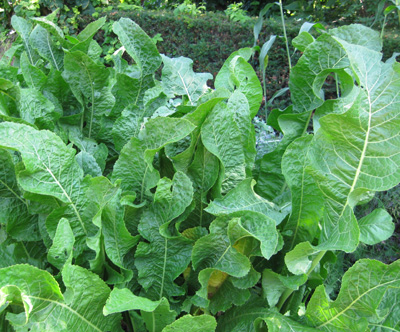
The International Herb Association named horseradish, Armoracia rusticana, as their Herb of the Year 2011. This perennial plant in the cabbage family (Brassicaceae) is now grown for its root that is used to create a condiment, although in the Middle Ages both the leaves and root were used medicinally. The leaves are edible raw or cooked but rarely eaten. It is thought to be native to southeastern Eastern Europe and western Asia but is now cultivated around the world. It was brought to North America by the colonists. Most of the commercial production in the US is in California, New Jersey, Virginia, Illinois and Wisconsin. Japanese horseradish, or wasabi, is a totally different plant (Wasabi japonica). It is an aquatic plant grown in cool, continuously running streams for the pungent stems or petioles. A substitute for true wasabi is made from ground horseradish, added flavors and green coloring.
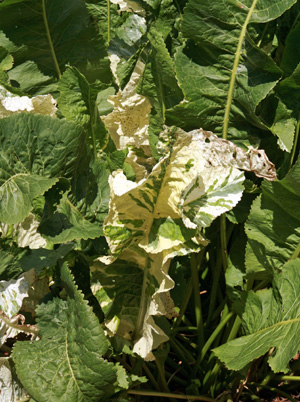
Horseradish plants grow as a rosette about 2 feet tall with a spread of 18 inches or more. The large, coarse, undulating leaves that grow on long stems from the crown provide a textural contrast in the herb garden. The textured leaves are dark green, except in ornamental types which have irregular variegation in white or cream. The cultivar ’Variegata’ is a striking plant with variable markings. Some leaves have big blotches, others have fine markings and some are almost completely white. The variegation may disappear when transplanted but will eventually return once the plant is well established.

In early summer, small white flowers are produced in terminal or axillary racemes on a tall flower stalk. The flowers are followed by small oblong seed pods.
The large, white, fleshy, tapered roots have a hot bitter taste. The pungency of the root comes from mustard oils (glucosinolates) released from the damaged plant cells when cut or grated. This quickly degrades and becomes unpleasantly bitter if not used immediately or mixed with vinegar to stop the degredation. These compounds will make your eyes water like onions can.
Armoracia does best in full sun but will tolerate partial shade. It prefers deep, moist soil but will grow just about anywhere. Lighter soils are best to aid in annual digging. Roots should be planted so the top of the root (where the shoots emerge) is at or just slightly below the soil level. Place the 8-12″ root segments vertically or at up to a 45 degree angle in the soil. Alternatively, the roots can be placed so that a few inches remain above the ground and then additional soil can be hilled up around the roots to cover them. They can be planted in fall or spring, from divisions or root cuttings purchased from a nursery or garden center (or possibly even from a grocery store). It has few pests, although imported cabbageworm larvae and flea beetles will chew holes in the leaves. Horseradish requires little maintenance after planting. However, if large, straight roots are desired, trimming the top part of the main root will produce a better product. Carefully pull the soil back from around the crowns when the leaves are about a foot tall. Cut off all side roots and leave only 2-3 sprouts forming leaves. Repeat the process 4-6 weeks later.
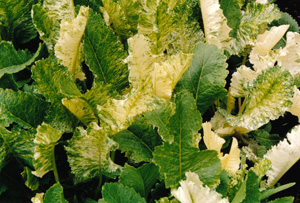
This plant is hardy in zones 2-9 and may be difficult to eradicate once established because the smallest piece of root can grow a new plant. The plant spreads by underground shoots, out-competes almost all other plants and can become invasive if not maintained. Burying a large plastic tub with the bottom cut out around the plant may help contain it. It can also be grown in a large, deep container if potential escape is an issue.
In commercial production there are two general types of horseradish, with the “common” type having broad crinkled leaves and superior root quality while “Bohemian” types have narrow smooth leaves and somewhat lower quality but better disease resistance. Specific varieties are rarely available to the homeowner, other than the ornamental ‘Variegata’.
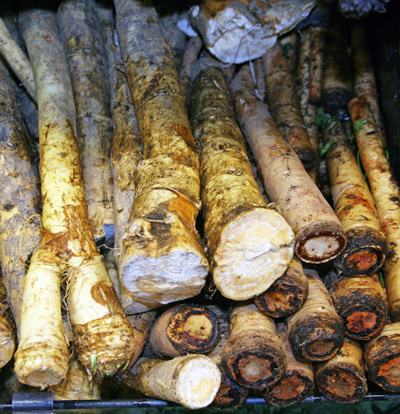
Horseradish is best when harvested in the fall after frost has killed the leaves or in early spring before growth resumes. Dig carefully to avoid damaging or breaking the large roots. After the roots are dug, the main root is harvested while the offshoots are replanted. Year-old roots have the most flavor. Older roots will be woody, pithy or hollow and not good for eating, although older plants can be dug to divide to start new plants. Spring-planted roots probably won’t be ready to harvest by the first fall; most gardeners dig those plants the following spring or fall.

In cooking, prepared horseradish (or just “horseradish”) refers to the grated root mixed with vinegar. Prepared horseradish should be white to cream colored. Horseradish sauce is generally prepared horseradish with cream or mayonnaise added. This hot spicy prepared horseradish or horseradish sauce is often served with meat, chicken, seafood, and in sandwiches.
Intact horseradish roots can be stored under cool, dark conditions with high humidity (eg. in a plastic bag in the refrigerator) for a few months.
– Susan Mahr, University of Wisconsin – Madison
Latest from Wisconsin Yard & Garden
Ask Your Gardening Question
If you’re unable to find the information you need, please submit your gardening question here:





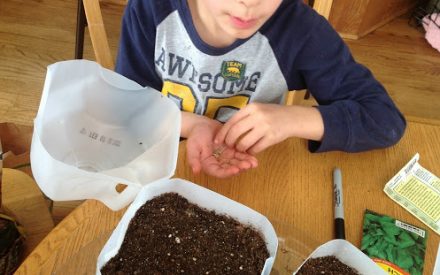 Seed Starting
Seed Starting Growing Vegetables at Home: Questions and Answers
Growing Vegetables at Home: Questions and Answers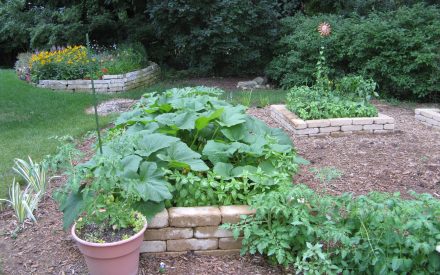 Growing Vegetables in Containers
Growing Vegetables in Containers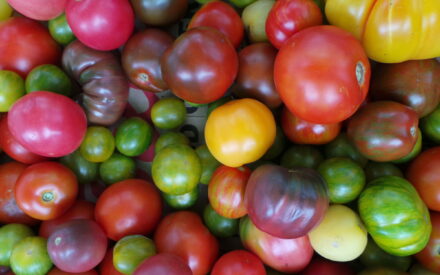 Homegrown Tomatoes for Wisconsin
Homegrown Tomatoes for Wisconsin


